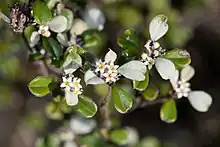| Stenanthemum leucophractum | |
|---|---|
 | |
| Scientific classification | |
| Kingdom: | Plantae |
| Clade: | Tracheophytes |
| Clade: | Angiosperms |
| Clade: | Eudicots |
| Clade: | Rosids |
| Order: | Rosales |
| Family: | Rhamnaceae |
| Genus: | Stenanthemum |
| Species: | S. leucophractum |
| Binomial name | |
| Stenanthemum leucophractum | |
| Synonyms[1] | |
| |
Stenanthemum leucophractum, commonly known as rusty poison, white cryptandra or white stenanthemum,[2] is a species of flowering plant in the family Rhamnaceae and is endemic to south-eastern continental Australia. It is a spreading shrub or subshrub with softly-hairy young stems, egg-shaped to fan-shaped leaves and heads of white or yellowish flowers surrounded by white, felt-like floral leaves.
Description
Stenanthemum leucophractum is a soft, spreading shrub or subshrub that typically grows to a height of 25–40 cm (9.8–15.7 in), its branchlets covered with woolly, rust-coloured hairs. Its leaves are egg-shaped to heart-shaped with the narrower end towards the base, to spatula-shaped, 3–10 mm (0.12–0.39 in) long and 2.5–8 mm (0.098–0.315 in) wide, with linear stipules 2–3 mm (0.079–0.118 in) long and joined together at the base. Both surfaces of the leaves are covered with whitish or rust-coloured hairs. The flowers are white or yellowish, and arranged in sessile heads 5–10 mm (0.20–0.39 in) wide, surrounded by small brown bracts and 2 or more whitish, felt-like floral leaves. The floral tube is 2.5–3.5 mm (0.098–0.138 in) long and 0.8–1 mm (0.031–0.039 in) wide, the sepals 1.0–1.2 mm (0.039–0.047 in) long and the petals 0.5–0.6 mm (0.020–0.024 in) long. Flowering occurs from September to December, and the fruit is an oval capsule 2.0–3.0 mm (0.079–0.118 in) long.[2][3][4][5][6]
Taxonomy and naming
Stenanthemum leucophractum was first formally described in 1847 by Diederich Franz Leonhard von Schlechtendal who gave it the name Cryptandra leucophracta in the journal Linnaea.[7] In 1858, Siegfried Reissek changed the name to Stenanthemum leucophractum.[8] The specific epithet (leucophractum) means "white-protected", referring to the floral leaves.[9]
Distribution and habitat
Rusty poison grows in mallee and is found in north-western Victoria, including in the Little Desert National Park, from the Eyre Peninsula to Kangaroo Island in South Australia, and between the Ardlethan and Hillston districts of inland New South Wales.[2][3][4][6]
References
- 1 2 "Stenanthemum leucophractum". Australian Plant Census. Retrieved 29 December 2022.
- 1 2 3 Kellerman, Jurgen; Thiele, Kevin R. Kodela, Phillip G. (ed.). "Stenanthemum leucophractum". Australian Biological Resources Study, Department of Agriculture, Water and the Environment: Canberra. Retrieved 2 January 2023.
- 1 2 Harden, Gwen J. "Stenanthemum leucophractum". Royal Botanic Garden Sydney. Retrieved 2 January 2023.
- 1 2 Walsh, Neville G. "Stenanthemum leucophractum". Royal Botanic Gardens Victoria. Retrieved 2 January 2023.
- ↑ "Cryptandra leucophracta". State Herbarium of South Australia. Retrieved 2 January 2023.
- 1 2 Kellermann, Jürgen; Thiele, Kevin R. (2021). "The other 'propeller plant' – Notes on Stenanthemum Reissek (Rhamnaceae: Pomaderreae) and a key to the genus in Australia" (PDF). Swainsona. 35: 18. Retrieved 3 January 2023.
- ↑ "Cryptandra leucophracta". APNI. Retrieved 2 January 2023.
- ↑ "Stenanthemum leucophractum". APNI. Retrieved 2 January 2023.
- ↑ Sharr, Francis Aubi; George, Alex (2019). Western Australian Plant Names and Their Meanings (3rd ed.). Kardinya, WA: Four Gables Press. p. 239. ISBN 9780958034180.